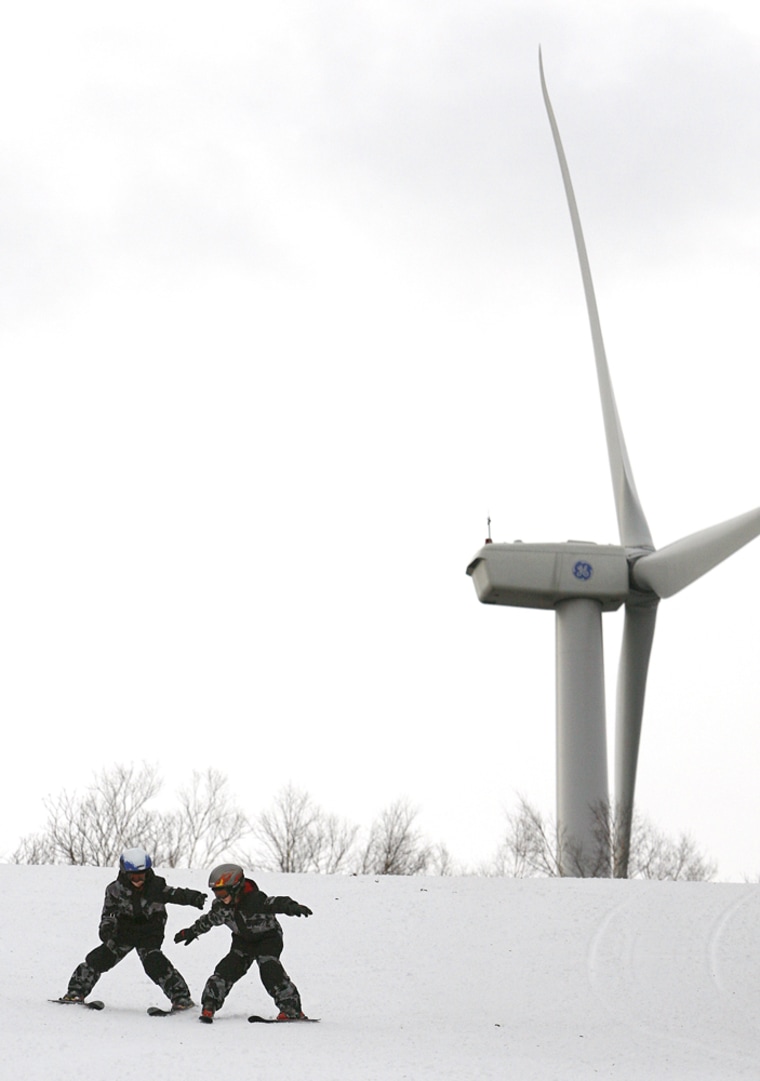Brian Fairbank had tried just about everything to cut the costs of running his Jiminy Peak ski resort: he used recycled motor oil to heat its mountain operations center, developed more efficient snow guns, captured heat generated by snowmaking machines, even installed waterless toilets.
Still his annual electric bill hit $635,000.
So Fairbank decided to do what no ski resort owner had done: install a giant windmill to make his own power.
Other ski resorts, smarting from criticism over soaring energy and water use as well as their impact on fragile ecosystems, are now watching Jiminy's 386-foot, $3.9 million turbine to see if it might work elsewhere.
The ski industry has pushed to redefine its image, with resorts switching to more environmentally friendly power and buying renewable energy credits to offset greenhouse gas emissions.
The industry is trying to turn profits while confronting the prospects of snow retreating to higher altitudes, later snowfalls and earlier snow melts.
In 2006, Vail Resorts took the lead by purchasing nearly 152,000 megawatt hours of wind energy credits to offset all of its annual power consumption its five ski areas and other businesses, making it one of the largest corporate users in the nation.
At British Columbia's Whistler Blackcomb resort, construction is expected to end in November on a $32 million hydro electric power project that will offset the annual energy consumption at the ski area. The Fitzsimmons Creek Hydro Project will produce 33.5 gigawatt hours of electricity a year, enough to send the facility into greenhouse gas production deficit, said Arthur De Jong, mountain planning manager.
Zephyr also a tourist attraction
At Jiminy Peak, the wind turbine, nicknamed Zephyr after the Greek god of the west wind, has become a tourist attraction at southern New England's largest ski resort.
It also cut Fairbank's electricity costs by $200,000 last year — the first full year the turbine was operational.
"The wind turbine came about because we had done all these things and there was no more low-hanging fruit," said Fairbank, who has run the resort for three decades. "We now make twice the amount of snow, with half the amount of money that we did 15 years ago."
Bill Swersey, of Manhattan, N.Y., who has skied at the western Massachusetts resort on the New York border every year since the late 1970s, says the turbine is a powerful symbol of environmentally friendly skiing.
"I think that you sometimes feel like skiing is an indulgence sport. You know it uses a lot of energy between the lifts and the snowmaking and the lighting ... and the fact that they can offset even some of it with wind energy is great," said Swersey, a Web site manager.
David Rooney, president of the nonprofit Berkshire Economic Development Corp., said Jiminy Peak has become a model for large-scale renewable energy production at ski resorts.
"I think that it's changed the skiing experience in that it's shown skiers that you can have renewable energy projects right on the mountain side, that you can bring renewable energy together with your skiing experience and have that add to that experience," Rooney said. "Green skiing sells."
Others eye wind turbines
Many resorts are studying wind power, including Aspen in Colorado, Blue Mountain and Shawnee Mountain in Pennsylvania as well as Grouse Mountain in North Vancouver, said Troy Hawks, spokesman for the National Ski Areas Association.
In the rugged Sierra Nevada range, the Kirkwood ski resort near Lake Tahoe is looking at installing 20 turbines, he said.
"Prior to this, they were buying renewable energy credits, basically they were paying a premium ... so the next step only made sense that they would have a wind turbine on their property generating electricity," Hawks said.
It is easier said than done.
First, the question of funding.
Jiminy Peak originally planned to spend $1.8 million on a smaller turbine. Fairbank said suppliers declined to bid for a single turbine until the energy unit of General Electric Co. agreed to provide the 1.5 megawatt unit, which doubled costs to $3.9 million.
The project was funded through a complicated combination of bank loans and a state grant and renewable energy credits sold to from the Massachusetts Technology Collaborative and Community Energy Inc., a Radnor, Pa. wind farm developer and marketer of such credits. Renewable energy credits are typically bought by businesses and utilities trying to offset greenhouse-gas emissions and others looking to support alternative energy.
Jiminy Peak now expects to earn more than $200,000 a year by selling power through the National Grid utility and producing tax credits.
Money secured, there was a big question of logistics.
About 500 tons of parts and equipment had to be transported along a two-mile, 26-percent-grade road up the mountain, including 123-foot-long blades.
Engineers were forced to use a ski trail to get parts and equipment to the desired spot. The frame of the trailer originally intended to haul equipment up the mountain bent under the stress on the first attempt, forcing Jiminy Peak to build a custom flatbed trailer. Four bulldozers supplied additional power and traction.
Once installed on the mountain's western shoulder, the turbine quickly became part of the landscape in this small town in the Berkshires.
